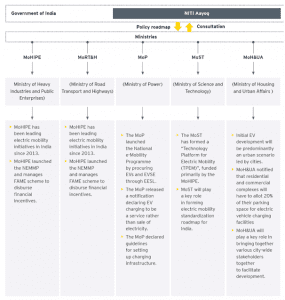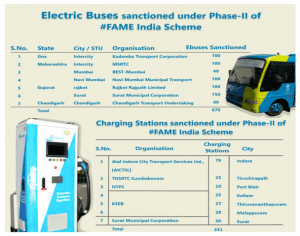Table of Contents
THE CONTEXT: The progression to electric vehicles(EVs) is important for India because such vehicles are sustainable and profitable in the long term. Reducing dependence on crude oil will save the government money, reduce carbon emissions, and build domestic energy independence. Besides being an economically and environmentally viable option, India’s transition to electric vehicles will allow us to fine-tune our infrastructure.
THE TRANSITION TOWARDS ELECTRIC MOBILITY
The transition towards electric mobility offers India not only an opportunity to improve efficiency and transform the transport sector but also addresses several issues that the country is currently grappling with. The concerns regarding energy security and rising current account deficit (CAD) on account of rising fossil fuel imports can be addressed with the uptake of electric mobility.
India is a power surplus country and is currently witnessing lower plant load factors due to lower capacity utilization. As per the conservative estimates, demand from electric vehicles (EV) could greatly improve the utilization factor of underutilized power plants, as charging pattern of EV users is considered to coincide with power demand during the non-peak hours in the country.
India has a clear intention of multiplying its generation from renewable energy (RE) sources which are inherently intermittent. Several reports suggest that EVs can complement the intermittent nature of power generated from RE by absorbing power at off-peak hours. The batteries in EVs can act as ancillary services for the proliferation of distributed generation resources (DER).
Apart from supporting RE generation, EVs with feasible vehicle to grid technology can act as a dynamic storage media and can enhance the grid resilience through ancillary market. This can reduce the burden of exchequer to create static energy storage systems, especially in distribution networks, to support proliferation of grid-connected roof top solar and DERs.
ELECTRIC MOBILITY INITIATIVES IN INDIA
Electric mobility initiatives in India, initially, were led by the Ministry of Heavy Industries and Public Enterprises (MoHIPE) who launched the National Electric Mobility Mission Plan (NEMMP) in 2013 and Faster Adoption and Manufacturing of (Hybrid &) Electric Vehicles in India (FAME India) in 2015. Over the years, identifying cross-sectoral complex linkages of electric mobility and achieving a multi-stakeholder development NITI-Aayog was mandated to anchor and coordinate the Electric mobility efforts in India.

Coordinated efforts resulted in six key facilitative initiatives, namely, FAME II, Urban facilitation, power sector facilitation, evolving tax regime, public private alliances and demand aggregation, which are attributed for the development of electric mobility in India.
The FAME India Scheme
- The FAME India Scheme is aimed at incentivizing all vehicle segments.
Two phases of the scheme:
- Phase I: started in 2015 and was completed on 31st March, 2019
- Phase II: started from April, 2019, will be completed by 31st March, 2022
- The scheme covers Hybrid & Electric technologies like Mild Hybrid, Strong Hybrid, Plug in Hybrid & Battery Electric Vehicles.
- Monitoring Authority: Department of Heavy Industries, the Ministry of Heavy Industries and Public Enterprises.
Fame India Scheme has four focus Areas:
- Technology development
- Demand Creation
- Pilot Projects
- Charging Infrastructure
Objectives of FAME Scheme:
- Encourage faster adoption of electric and hybrid vehicles by way of offering upfront Incentive on purchase of Electric vehicles.
- Establish a necessary charging Infrastructure for electric vehicles.
- To address the issue of environmental pollution and fuel security.

SHIFTING ENERGY RESOURCES FROM MIDDLE EAST TO LATIN AMERICA
The government has allocated $1.3 billion in incentives for electric buses, three-wheelers and four-wheelers to be used for commercial purposes till 2022, and earmarked another $135 million for charging stations. Besides these incentives, a proposal for a $4.6 billion subsidy for battery makers has also been proposed by the NITI Aayog.
These policies are embedded with the vision to have 30% electric vehicles plying the roads by 2030. In September 2019, Japanese automobile major Suzuki Motor formed a consortium with Japanese automotive component manufacturer Denso and multinational conglomerate Toshiba to set up a manufacturing unit in Gujarat to venture into the production of lithium-ion batteries and electrodes.
Developing domestic battery manufacturing capacity may fundamentally change India’s relationship with resource-rich Latin America as the government plans to buy overseas lithium reserves.
India’s energy security dependence will shift from West Asia to Latin America. India imported 228.6 MT of crude oil worth $120 billion in 2018–19, which made it the third-largest oil importer in the world in terms of value.
Lithium triangle

Latin America’s famous lithium triangle that encompasses lithium deposits under the salt flats of northwest Argentina, northern Chile, and southwest Bolivia holds about 80% of the explored lithium of the world. In Latin America, most of the production comes from Argentina, Chile, and Bolivia.
At present, India’s lithium-ion battery demand is fulfilled by imports from China, Vietnam, and Hong Kong. In the last two years, India has had a growing appetite for lithium-ion batteries, and so, lithium imports have tripled from $384 mn to $1.2 bn.Notably, the government has intercepted this growing demand from its incipience. With its policy intervention to support battery manufacturers by supplying lithium and cobalt, this industry is more likely to grow domestically to support India’s goal to switch to electric mobility.
CHALLENGES FOR INDIA’S ELECTRIC MOBILITY INITIATIVES
Presently, India is one of the fastest growing economies in the world, but its increasing dependency on oil imports, rising environmental concerns and growing need for sustainable mobility solutions are posing serious economic and social challenges for the country. Some of these changes are following:
Rising crude oil imports –an energy security challenge
Since the early 2000, India’s crude oil imports have risen exponentially reaching a record high of 4.3mb/d in 2016. The demand for oil grew by 5.1% in 2016, higher than the world’s largest net importers, the US (0.7%) and China (2.9%), making India the world’s third largest crude oil consumer.
India’s crude oil deficits stood at US$52 billion in 2017 and accounted for almost 50% of the total trade deficit of US$109 billion. This crude oil deficit is further expected to almost double to US$100 billion against the total trade deficit of US$202 billion in 2019.
Rising pollution levels –An environmental challenge
India ranks as the third largest carbon emitting country in the world accounting for 6% of the global carbon dioxide emissions from fuel combustion. According to the WHO Global Air Pollution Database (2018), 14 out of the 20 most polluted cities of the world are in India.
Rising population –A sustainable mobility challenge
India’s current population of 1.2 billion is expected to reach 1.5 billion by 2030. Out of the 1.5 billion people, 40% of the population is expected to live in urban areas compared to 34% of 2018 population projection. The additional 6% population growth is likely to further add strain on the struggling urban infrastructure in the country, including a rise in demand for sustainable mobility solutions.
Evolving global automotive market –A manufacturing transition challenge
India is the world’s fourth largest producer of internal combustion engine (ICE) based automobiles. The growth in automotive market in India has been the highest in the world, growing at a rate of 9.5% in2017. The recent shift in global automotive technology and an increasing uptake in electric vehicles is likely to pose a challenge to the existing automotive market if the country does not plan its transition towards newer mobility solutions and develop the required manufacturing competencies.
ELECTRIC MOBILITY: A POTENTIAL SOLUTIONS FOR INDIA
In India, majority of the oil demand comes from the transport sector. The sector accounts for over 40% of the total oil consumption with around 90% of the demand arising from the road transport.
By 2020, 330 mt(million tons) of carbon emissions are expected to arise from the transportation sector, 90% of which may be from road transport alone.
The premier think tank of GoI, NITI Aayog (National Institution for Transforming India), reports that India can save 64% of anticipated passenger road-based and mobility-related energy demand and 37% of carbon emissions by 2030 if it pursues electric mobility in future.
This would probably result in an annual reduction of 156 MToE in diesel and petrol consumption for 2030, saving India INR3.9 lakh crores (or ~US$60 billion (at US$52/bbl of crude)).
The cumulative savings for the tenure 2017-2030 is expected to reach 876 MToE of savings for petrol and diesel, which totals to INR 22 lakh crores (or ~US$330 billion), and 1 gigaton for carbon-dioxide emissions.
WAY FORWARD:
The Indian market needs encouragement for indigenous technologies that are suited for India from both strategic and economic standpoint.
Since investment in local research and development is necessary to bring prices down, it makes sense to leverage local universities and existing industrial hubs.
Breaking away the old norms and establishing a new consumer behaviour is always a challenge. Thus, a lot of sensitization and education is needed, in order to bust several myths and promote EVs within the Indian market.
Subsidizing manufacturing for an electric supply chain will certainly improve the EV development in India. Along with charging infrastructure, the establishment of a robust supply chain will also be needed. Further, recycling stations for batteries will need to recover the metals from batteries used in electrification to create the closed-loop required for the shift to electric cars to be an environmentally-sound decision.
CONCLUSION:
Operationalizing mass transition to electric mobility for a country of 1.3 billion people is a great challenge. Thus, a strong common vision, an objective framework for comparing state policies and a platform for public-private collaboration are needed. In the present scenario, India must need to change its energy policy- from the Middle East to Latin America.
Spread the Word
